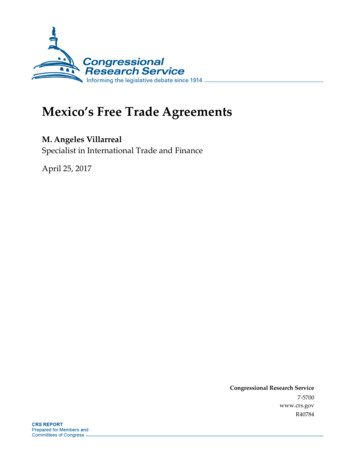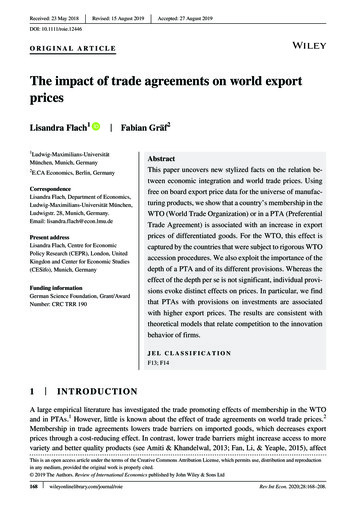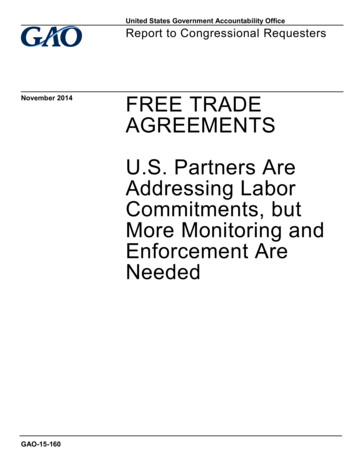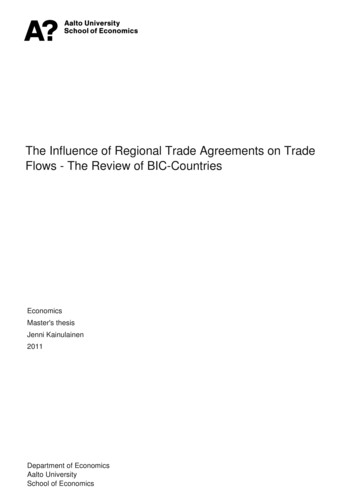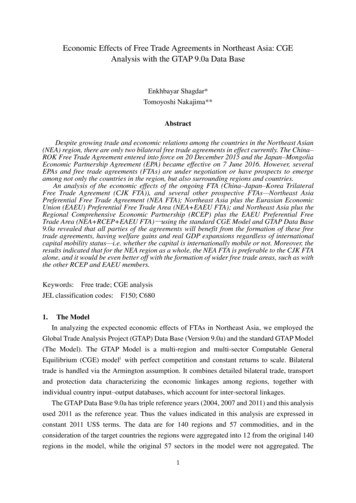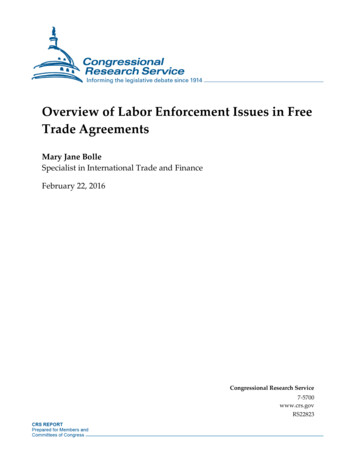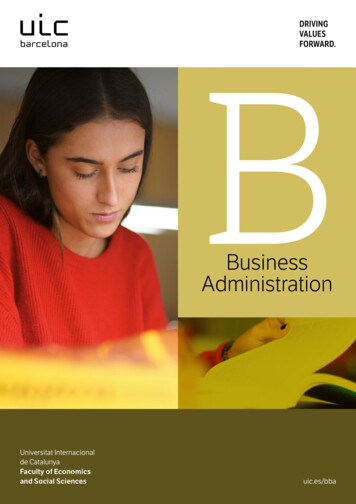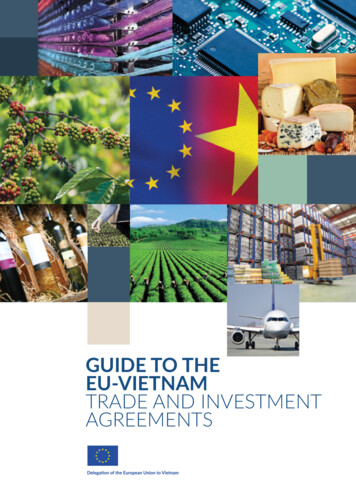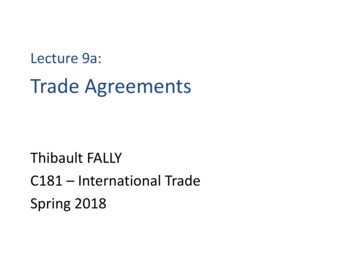
Transcription
Lecture 9a:Trade AgreementsThibault FALLYC181 – International TradeSpring 2018
IntroductionInternational agreements:1) Trade agreements WTO Regional trade agreements2) Agreements on labor issues3) Agreements on environmental issues
IntroductionTrade agreements: Motivation A large country applying a tariff sees an improvement ofits terms-of-trade, which can generate welfare gains However, if two trade partners apply a tariff, both loose Trade agreements can generate gains for both parties
Home gains e - (b d)
Foreign gains - (e f) 0(i.e. loss: decrease in producer surplus!)
IntroductionGlobal effect of tariff: Home gains: e - (b d) Foreign loss: - (e f) Net gains if both apply tariffs on imports: - (f b d) 0
IntroductionTrade war payoff matrixPayoffs in a Tariff Game This payoff matrix shows the welfareof the Home and Foreign countries as compared with freetrade (upper-left quadrant in which neither country applies atariff). Welfare depends on whether one or both countriesapply a tariff.
1- Trade AgreementsNash equilibrium: All countries apply a tariff! Outcome similar to the prisoner’s dilemmaGoal of the GATT: remove off-diagonal cell: By removing off-diagonal cells, the Nash equilibrium isnow free trade
1- Trade AgreementsTrade war payoff matrixBy imposing reciprocity and removing off-diagonal cells, theGATT has successfully induced lower tariffs among itsmembers. Free trade is now the only Nash equilibrium.
2- A brief history of the WTOAfter World War II, representatives of the Alliedcountries met on several occasions to discussissues such as high trade barriers and unstableexchange rates.In 1947 the General Agreement on Tariffs and Trade(GATT) was established. The purpose of which wasto reduce barriers to international trade betweennations.Now: World Trade Organization (WTO)
2- A brief history of the WTOSome of the GATT’s main provisions are as follows:1. A nation must extend the same tariffs to all tradingpartners that are WTO members.2.Tariffs may be imposed in response to unfair tradepractices such as dumping.
2- A brief history of the WTOGATT’s provisions:3.Countries should not limit the quantity of goodsand services that they import.4.Countries should declare export subsidiesprovided to particular firms, sectors, or industries.Article XVI deals with export subsidies, andstates that countries should notify each otherof the extent of subsidies and discuss thepossibility of eliminating them.
2- A brief history of the WTOGATT’s provisions:5.Countries can temporarily raise tariffs for certainproducts. Article XIX, called the safeguardprovision or the escape clause, is our focus in thischapter.The importing country can temporarily raisethe tariff when domestic producers aresuffering due to import competition.
2- A brief history of the WTOSome of the GATT’s main provisions are as follows:6. Regional trade agreements are permitted underArticle XXIV of the GATT.The GATT recognizes the ability of blocs ofcountries to form two types of regional tradeagreements:(i)free-trade areas, in which a group of countriesvoluntarily agree to remove trade barriersbetween themselves(ii) customs unions, which are free-trade areas inwhich the countries also adopt identical tariffsbetween themselves and the rest of the world
2- A brief history of the WTOKey Provisions of the GATTArticle IArticle VIArticle XIArticle XVIArticle XIXArticle XXIVGeneral Most-Favored-Nation TreatmentAnti-Dumping and Countervailing DutiesGeneral Elimination of QuantitativeRestrictionsSubsidiesEmergency Action on Imports of ParticularProductsTerritorial Application—Frontier Traffic—Customs Unions and Free-Trade Areas
3- Regional Trade AgreementsRegional Trade AgreementsUnder regional trade agreements, several countrieseliminate tariffs among themselves but maintain tariffsagainst countries outside the region.Regional trade agreements are sometimes called“preferential” trade agreements, to emphasize that themember countries are favored over other countries.Free-Trade Area A free-trade area is a group of countriesagreeing to eliminate tariffs (and other barriers to trade)among themselves but keeping whatever tariffs theyformerly had with the rest of the world.
3- Regional Trade AgreementsRegional Trade AgreementsCustoms Union A customs union is similar to a free-tradearea, except that in addition to eliminating tariffs amongcountries in the union, the countries within a customsunion also agree to a common schedule of tariffs witheach country outside the union.Rules of Origin Free-trade areas have complex rules oforigin, which specify what type of goods can be shippedduty-free within the free-trade area. These rules are notneeded in a customs union.
Other international agreements:2) Agreements on labor issues3) Agreements on environmental issues
4- International agreements on labor issuesWe use the term labor standards to refer to all issuesthat directly affect workers, including occupationalhealth and safety, child labor, minimum wages, and soon.Labor Side Agreement under NAFTAThe labor side agreement negotiated under NAFTAdoes not change the existing labor laws in thesecountries but is meant to improve the enforcement ofsuch laws.
4- International agreements on labor issuesOther Labor AgreementsCorporate Responsibility Because of the pressure from consumers andunions, corporations have started to monitor and improve the conditionsin their overseas plants and the plants of their overseas subcontractors.Country Responsibility Several U.S. trade laws give the president thepower to withhold trade privileges from countries that do not give theirworkers basic rights, including the right to organize.Living Wage Is it fair to expect foreign firms to pay a living wage totheir workers, that is, a wage above the norm in the developingcountry? Economists have a ready answer: the wages should be ashigh as the market will allow, and not any higher.
Environmental Issues and the prisoner’s dilemmaNeed for agreements:
5- Agreements on environmental issuesEnvironmental Issues in the GATT and WTO The WTO does not directly addressenvironmental issues; Other international agreements, calledmultilateral environmental agreements, dealspecifically with the environment.
5- Agreements on environmental issuesOther examples:- Gasoline imports from Brazil and Venezuela;- Exports of genetically-modified crops and food to the E.U.
5- Agreements on environmental issuesThe Kyoto Protocol and the Copenhagen AccordThe Kyoto Protocol built on the United Nations’ 1992treaty on climate change, established specific targetsfor reduction in greenhouse gas emissions: theindustrial countries should cut their emissions ofgreenhouse gases by a collective 5.2% less than their1990 levels.
5- Agreements on environmental issuesThere are four reasons often given to explain why theUnited States did not join the Kyoto Protocol:(1) although the evidence toward global warming isstrong, we still do not understand all theconsequences of policy actions;(2) while the United States is the largest emitter ofgreenhouse gases, meeting the Kyoto targets wouldnegatively affect its economy;(3) Kyoto failed to include the developing countries,especially China and India;(4) there are other ways to pursue reductions ingreenhouse gas emissions.
Trade policy quiz1- The most efficient trade policy tool to maximize domesticwelfare is:a) Tariffb) Quotac) Voluntary export restraintd) Anti-dumping laws
Trade policy quiz2- Tariffs were historically the highest during:a) The Great Recession, 2008-2010b) The post-war period, 1950-1970c) Around late 19th centuryd) Early 19th century
Trade policy quiz3- Countries would set up a positive tariffs in order to:a) Maximize consumer surplusb) Maximize the sum of consumer and producer surplusc) Improve the terms of traded) Improve global welfare
Trade policy quiz4- About the World trade organization (WTO):A- The WTO prohibited all sorts of tariffs in mostindustries:a) Trueb) False
Trade policy quiz4- About the World trade organization (WTO):B- The WTO prohibited all sorts of quotas in mostindustriesa) Trueb) False
Trade policy quiz4- About the World trade organization (WTO):C- The WTO does not require countries to removesubsidiesa) Trueb) False
Trade policy quiz4- About the World trade organization (WTO):D- The WTO does not require to remove anti-dumpinglawsa) Trueb) False
Trade policy quiz4- About the World trade organization (WTO):E- Countries are not allowed to impose higher tariffs tosome member countries than others, with the exception offree trade agreementsa) Trueb) False
Regional Trade Agreements Free-Trade Area A free-trade area is a group of countries agreeing to eliminate tariffs (and other barriers to trade) among themselves but keeping whatever tariffs they formerly had with the rest of the world. Under regional trade agreements, several countrie
